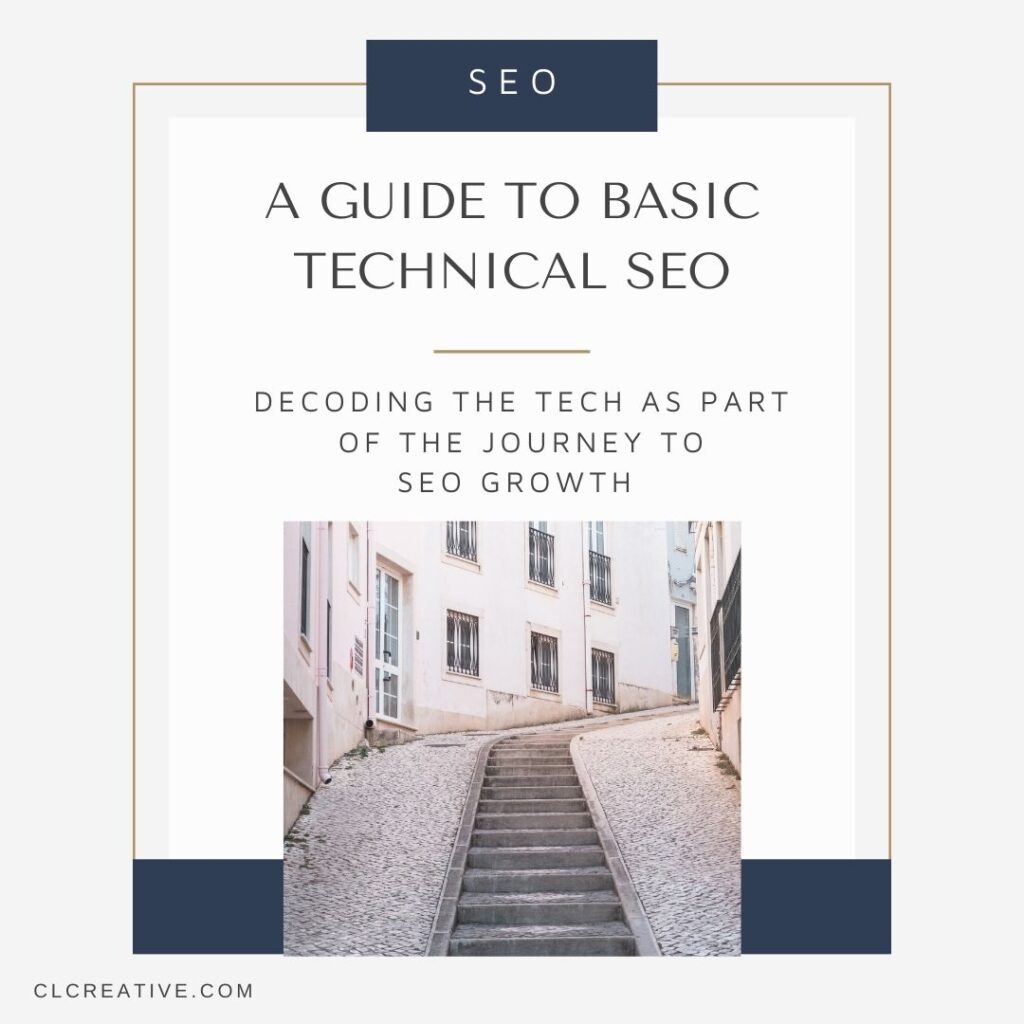
The final post in our blog series on search engine optimization deals with technical SEO. Though it often feels extremely overwhelming for someone who isn’t comfortable in the tech/code world, technical SEO is really where I come in. My clients know that their site files are already optimized as part of the custom development work that goes into their site creation. That said, there are some content-related aspects (read: not as technical) that are worth knowing; becoming familiar with what goes into technical SEO efforts, even if executing them seems complex, is critical to overall SEO growth. Technical SEO provides a solid foundation on which to launch greater SEO efforts.
What is Technical SEO?
Technical SEO is a subcomponent of on-page SEO, which looks to improve technical aspects of your website in order to more effectively index it, thus improving organic (i.e., non-paid) rankings. Speed optimizations (both in your website content and at the server-level), proper code so that search engines understand your site’s content, and generally making it easy for Google to crawl, are the cornerstones of technical SEO.
Characteristics of a Technically-Optimized Website
Feel the Need for Speed
Out of the gate, your website has got to be fast. Honestly, people are impatient and don’t want to wait for something to load so you have to speed things up before they bounce off. Speed optimizations come via a collection of methods, including:
- Optimizing image sizes (smaller files load faster)
- Minifying site code, including CSS, javascript and HTML files, by removing all the unnecessarily spaces and line breaks (there are websites that do this for you and you can copy/paste; I have specialized programs that handle it for me)
- Keeping ‘HTTP requests’ to a minimum, which can be achieved through conservative use of scripts and plugins
- Springing for the faster hosting packages
Of those four main items, two of them are readily within your control: optimizing images and your hosting plan. When it comes to hosting, you definitely get what you pay for. One of the best analogies I’ve heard is that those $1.99/month plans are the equivalent of living in an apartment building and sharing a water heater with the whole building. Good luck getting a hot shower!
Shared hosting means there are a lot of other websites in your space, taking up the horsepower that you want to use to load your site quickly and efficiently. Google rewards fast sites because it’s an indicator of a positive page experience, so springing for more bandwidth is always worth it.
Lock Your Site Down with an SSL Certificate
Many page-builder websites (ahem, Squarespace) and hosting packages include an SSL certificate by default now, but it’s worth double-checking. SSL stands for Secure Sockets Layer and is the technology that creates an encrypted connection between the server and the user’s browser. The dead giveaway of a website using SSL is the ‘https://’ in the URL instead of ‘http://’ or possibly the giant red message you might see in browser warning you that the site you’re about to visit is not secure. In 2014, Google announced that they would be giving priority to sites who serve their webpages securely over SSL, so it became even more important to implement.
Make it Responsive and Mobile-Friendly
Sometimes I almost forget that this issue still needs to be addressed because it’s so second nature to me, but your site must be mobile-ready and optimized for phones and other mobile devices. During new client calls, I often forget to mention that all of the sites I design and develop are responsive because in my mind, of course I would be designing a responsive site; but it’s an important question to ask! If your designer/developer or the theme that you’re considering aren’t optimized for mobile, that is a huge red flag.
A responsive site means the content will adjust to the device while maintaining ease of navigation and readability. Gone are the days when companies had a desktop website (www.companyname.com) and a phone-friendly separate website (m.companywebsite.com — does anyone remember those??) Now Google wants to see your one, fully-integrated site that looks great and provides a positive user experience in both mobile and desktop forms.
Google makes it pretty clear that a responsive site is a major ranking factor and now that they approach indexing sites with a mobile-first attitude (i.e., they look to crawl the mobile version of your site’s content), a responsive site is a must-have.
Let Google Know You’re Alive
It’s important to provide Google with a roadmap to your site. Registering your site with Google Search Console and supplying an XML site map are great ways to do this. My go-to WordPress SEO plugin, Yoast, creates a sitemap for you and then you can easily submit it to Search Console. The sitemap contains helpful data like page modification date, how frequently it gets updated and even page hierarchy, all of which assist search engines with crawling.
Make Use of Structured Data
Structured data is the code created using schema markup to help search engines understand your site and content better. Using schema properly can guide search engines as to the type of content you provide, whether it be products or recipes or a portfolio, to name a few. This type of data will help search engines index your site appropriately and more effectively, ultimately providing more relevant results.
This type of info doesn’t always have to be entered on your website as straight code: some page builders give you an opportunity in their SEO panels to include the info, then they translate it accordingly, but it’s up to you to make use of it.
Approachable Technical SEO Tactics to Get Started
If much of that seemed complicated, I get it. For anyone not in a tech/code world, it seems like a lot. Here are a few ways you can improve technical SEO without all the complicated code knowledge:
- Be mindful of popups and other intrusive items that might annoy users, causing them to bounce off the site
- Examine your site’s navigation and structure; make sure it’s easy for users to find the info they want
- Evaluate your website’s URL structure; make sure you’re using keywords in the permalink or page slug/url that are relevant to the page topic
- Clean up broken links and 404 pages from your site
Conclusion
If all of that sounds overwhelming and jargon-y, I get it. That’s where the professionals come in. There is a lot of SEO legwork that can be achieved without technical knowledge, but sometimes, you have to get out of your comfort zone and learn something new, or pay the professionals. If you’d like a quick evaluation of your site’s technical SEO, drop me a line to get started!
